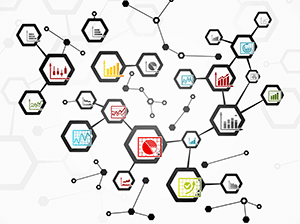For a digital transformation to be successful, organizations need to have a digital strategy connected with the organization general strategic objectives. This implies that the transformation process should be pervasive through the whole organization, it is no longer and IT or automatization issue. Implies having new digital products and services, a new and more innovative business model, a more complex channel strategy, an aggressive digital marketing and developing the right capabilities to offer customers a good digital experience. All of this of course needs to be supported by technology capabilities and platforms. This can only be achieved if the whole organizational landscape is described and understood. An ‘architectural landscape’ essentially represents the different components of the business – including business processes and information technology resources – making it possible to modify existing operating models in order to harness new technological trends in an efficient and timely manner.
Leveraging Segmentation to Secure IoT
The biggest challenge facing most organizations is simply identifying and tracking all IoT devices connected to the network. Network Access Control allows organizations to authenticate and classify IoT devices securely. Real-time discovery and classification of devices at the point of access allows IT teams to build risk profiles and automatically assign IoT devices to appropriate device groups, along with associated policies. ... Once the network has identified IoT devices, IT teams then need to establish IoT attack surface controls. Segmenting IoT devices and related communications into policy-based groups and secured network zones allow the network to automatically grant and enforce baseline privileges for specific IoT device profiles. While inventory management tools can track these devices, and behavioral analytics can monitor their behavior, Internal Segmentation Firewalls (ISFW) need to be applied to enable organizations to not only quickly and dynamically establish and control network segments but also inspect applications and other traffic that need to cross segmentation boundaries.
CDOs are a crucial hire for any organisation looking to unlock the value of their data. Companies sit on a mountain of data, including marketing and sales, finance, HR and operations and to store, process, analyse and use this data effectively requires a specific set of skills. They have a broad role, encompassing parts of other c-suite roles. But some companies mistake it with the chief information officer (CIO). However, whereas the CIO deals with the technology, infrastructure and software/data engineering of a company, the CDO should be more commercially minded. As Pete Williams, former analytics head at M&S explains: “The CIO can have responsibility to ingest data. But for a CDO, we are talking about a level of commercial awareness that needs to come from the business.” They look at how data can be used by a business to gain a competitive and commercial edge. CDOs are more important than ever, especially now the General Data Protection Regulation (GDPR) has become a business-as-usual requirement. Indeed, the hefty fine for infringing GDPR has helped to elevate data governance to board-level status.
The Future of Networking Is 5G: Businesses Must Prepare Now
Between now and 2020, a few things must still happen: The industry must complete the entire set of 5G standards. Even though most of the radio standards are defined, we have about another year of work on the core network standards. Expect to see both established service providers and startups, even some large enterprises, roll out localized wireless 5G networks over the next year. They will use slight modifications of the 4G core but take advantage of the current patchwork of 5G radio spectrum. Network trials and proof-of-concept applications will represent the bulk of those efforts. The real 5G core, with full network-slicing capability, will start to show up in large-scale production networks around 2020. Understanding 5G and its implications should be high on your company’s priority list. How will setting up a private 5G network slice improve your company’s critical applications, services and security processes? Could new network services open up revenue-generating opportunities?
The Smart City Trailblazers

Could smart canals ever become a reality? If so, Amsterdam is likely to lead the charge. As an early investor in smart technology, Amsterdam first hired a chief technology officer back in 2004, at a time before some of the foundational concepts of smart cities had terms we would recognize today. As with many smart cities, Amsterdam has long focused on transportation, and the use of satellite navigation technology and other sensor-derived data has provided a more pedestrian-friendly cityscape. The success of these transportation improvements is clear. The city had to update their traffic information in 2016, as the previous data, gathered in 2011, was already obsolete: In that time, the number of cars dropped by 25 percent, and the number of more efficient scooters rose by 100 percent. Amsterdam’s unified approach toward smart technology better enables it to combine both private and public efforts, leading to a cohesive approach that’s already paying off.
Safe Artificial Intelligence Requires Cultural Intelligence

Building machines that can perform any cognitive task means figuring out how to build AI that can not only learn about things like the biology of tomatoes but also about our highly variable and changing systems of norms about things like what we do with tomatoes. Humans live lives populated by a multitude of norms, from how we eat, dress and speak to how we share information, treat one another and pursue our goals. For AI to be truly powerful will require machines to comprehend that norms can vary tremendously from group to group, making them seem unnecessary, yet it can be critical to follow them in a given community. Tomatoes in fruit salads may seem odd to the Brits for whom Kington was writing, but they are perfectly fine if you are cooking for Koreans or a member of the culinary avant-garde. And while it may seem minor, serving them the wrong way to a particular guest can cause confusion, disgust, even anger. ... Norms concern things not only as apparently minor as what foods to combine but also things that communities consider tremendously consequential: who can marry whom, how children are to be treated, who is entitled to hold power, how businesses make and price their goods and services, when and how criticism can be shared publicly.
Bitcoin Blockchain Technology Implementation In India Not An Easy Task
There will be a complete transformation which will cost a fortune in the complete makeover along with a dedicated time. In addition to this, recruiting blockchain experts and data scientists is definitely much costlier as compared to hiring software developers. The biggest applications of blockchain rely on public frameworks such as Bitcoin and Ethereum. All the parties can make transactions within the same network that is monitored. But the entire process is expensive and needs a lot of investment to keep it under operation. For a government projects or any public blockchain-based applications, the role of cost bearer in terms of network maintenance and the validation of transactions is still not clear. Despite all the issues, there is a significant rise in the number of blockchain developer requirement in the market. It is even alleged that cryptocurrency and blockchain jobs are gradually more appealing to job seekers from more conventional sectors especially in Asia.
Onelink: IoT Smoke Alarm Now Alexa-Enabled

Onelink Safe & Sound is not your ordinary smoke alarm. It is a smart IoT alarm that could detect smoke and carbon monoxide in your home or office. Powered by First Alert’s technology for smoke and carbon monoxide detection, it has an 85-decibel alarm, and it also sends notifications to your mobile phone if the device detects any smoke or carbon monoxide within the premise. It also has a built-in Alexa voice service which allows you to access all the features found on Amazon Echo. You can use voice commands on Onelink Safe & Sound to play your favorite music, audiobooks, control smart devices, and even have it read the news. Also known as an electrochemical gas sensor is a gas detector that measures the density of a target gas by oxidizing or decreasing the target gas at an electrode and measuring the resulting current. To get your very own Onelink Safe & Sound Smoke and CO alarm, check out their product page on Amazon for easy ordering. The device can currently be bought for $241.53. There are also bundles that tie in Amazon Echo devices, in case you’re looking to buy one.
Building the Pillars of Data Modeling and Enterprise Architecture

Ruff said, “ER/Studio doesn’t do the Data Governance for you,” but Data Governance can’t be done without an Enterprise Architecture solution like ER/Studio as a foundation, “because if you’re not managing your data at the low level, you can’t manage it at a higher level,” she said. Having a complete model of the data gives business users access to that global vision they need and a thorough understanding of the value of that data. “It’s extremely important that every single thing that an organization does has a data representation and a process representation,” in the model, “because it’s really through the modeling that we are able to improve our business processes, improve our data quality, and everything else,” said Huizenga. ... The consequences of non-compliance can be great, so it’s vital to fully understand how regulations affect business practices. “You will need to verify that the safeguards you have in place are indeed sufficient, rather than just assuming they meet the requirements.” Compliance is an active process and it’s imperative that companies implement the appropriate protections proactively.
Transforming The Transformative: The CMO's Role In Leading Digital Transformation
As a CMO, it’s important to remember that technology alone won’t ensure your company’s DX is a success. When Forrester identified the capabilities most vital to DX success, just four out of the top 10 are technology-based. To accelerate digital transformation and drive revenue growth, CMOs must develop and redesign organizational capabilities like strategy, culture, change management, digital experiences, innovation management and customer journey mapping. Reshaping your culture to be customer-centric is essential in order to support continuous innovation and drive effective change throughout the organization. Unsurprisingly, data and analytics capabilities are most critical among technologies that drive digital transformation success. Modern marketers are data-driven, and in an age where customer experience is the ultimate factor that can make or break a brand, CMOs often rely on customer datawhen strategizing how to meet and exceed high customer expectations.
Quote for the day:
"Great leaders don't need to act tough. Their confidence and humility serve to underscore their toughness." -- @SimonSinek


No comments:
Post a Comment